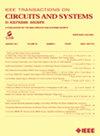A 2-MHz BW 64.5-dB SNDR 0.45-1.05 GHz Direct IF/RF Digitization Subsampling Bandpass DSM Utilizing a Capacitive-Stacking N-Path Filter
IF 4.9
2区 工程技术
Q2 ENGINEERING, ELECTRICAL & ELECTRONIC
IEEE Transactions on Circuits and Systems II: Express Briefs
Pub Date : 2025-07-10
DOI:10.1109/TCSII.2025.3587662
引用次数: 0
Abstract
This brief presents a novel subsampling bandpass Delta-Sigma modulator (BPDSM) based on transconductor (Gm) - N-path filters (NPF) for direct radio-frequency (RF) / intermediate-frequency (IF) digitization. The proposed architecture introduces two key innovations. First, a subsampling technique is applied that places the input center frequency at基于电容堆叠n路滤波器的2 mhz BW 64.5 db SNDR 0.45-1.05 GHz直接中频/射频数字化子采样带通DSM
本文介绍了一种基于半导体(Gm) - n路滤波器(NPF)的新型次采样带通Delta-Sigma调制器(BPDSM),用于直接射频(RF) /中频(IF)数字化。提出的体系结构引入了两个关键的创新。首先,应用子采样技术,将输入中心频率置于$(3/4)f_{S}$(相对于传统的$f_{S}/4$操作),其中$f_{S}$是采样频率。其次,利用电容堆叠NPF提供6 db无源增益:(1)当参考调制器输入时,抑制放大器的热噪声;(2)通过消除调制器噪声传递函数中$f_{S}/4$偶数倍处的冗余陷波,改善量化噪声整形。该调制器原型采用65纳米CMOS制造,占地0.11 mm2,实现0.45 - 1.05 GHz的可调性,这是作者所知的Gm-NPF bpdsm的最高频率。当时钟频率为800-MHz时,它在以601-MHz为中心的2-MHz带宽上显示出64.5 db峰值SNDR,从1.2 v电源消耗0.37 mW。对于工作在450 MHz以上的bpdsm,该设计记录了最先进的性能值(FoM)为161.8 dB Schreier FoM和67.4 fJ/转换步长Walden FoM。
本文章由计算机程序翻译,如有差异,请以英文原文为准。
求助全文
约1分钟内获得全文
求助全文
来源期刊
CiteScore
7.90
自引率
20.50%
发文量
883
审稿时长
3.0 months
期刊介绍:
TCAS II publishes brief papers in the field specified by the theory, analysis, design, and practical implementations of circuits, and the application of circuit techniques to systems and to signal processing. Included is the whole spectrum from basic scientific theory to industrial applications. The field of interest covered includes:
Circuits: Analog, Digital and Mixed Signal Circuits and Systems
Nonlinear Circuits and Systems, Integrated Sensors, MEMS and Systems on Chip, Nanoscale Circuits and Systems, Optoelectronic
Circuits and Systems, Power Electronics and Systems
Software for Analog-and-Logic Circuits and Systems
Control aspects of Circuits and Systems.

 求助内容:
求助内容: 应助结果提醒方式:
应助结果提醒方式:


